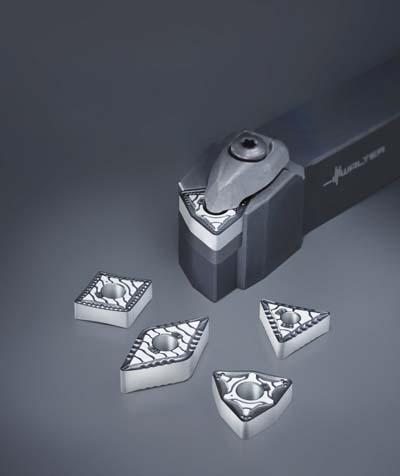
Walter USA LLC has announced that its Tiger-tec Silver for Turning product line has fielded four new cutting tool insert geometries: the RP5 for roughing, the MP5 for medium machining, the MP3 for low carbon steels, and the FP5 for finishing. Together, these new additions make Tiger-tec Silver for Turning a comprehensive, single-source solution for the full range of steel turning needs.
The rugged RP5 geometry excels at roughing with high depth of cut and feed rate. Its strong, positive 3°Chamfer reduces power requirements and its open, deep and wide chip breaker groove maintains low cutting temperature, reducing wear. A wider chamfer in the center region of the main cutting edge prevents chipping when machining as-cast or as-forged components.
The versatile MP5 geometry was specifically designed for general machining of steel. From continuous cutting of bar stock to interrupted cuts, the MP5 can handle them all with its universal, strong three-center curve cutting edge. In addition, its reinforced chip breaker blades ensure better chip breaking and reduced tool wear.
The MP3 geometry excels at medium machining on long chip forming steels such as low carbon and forging steels. Its cutting edge is ideal for machining forged parts such as gearwheels, ball joints, transmission shafts or cold pressed sheet components such as cover plugs or converter housings. The spherical surface features in the chipbreaker--the so-called "bullet design"--gives the chip greater rigidity for optimal chip breaking.
For finishing operations and light cuts, the FP5's double V chip breaker provides reliable chip control during turning operations from 0.008-in. depth of cut. It has a positive, curved cutting edge to reduce the tendency to oscillate, thus allowing excellent surface finishes; and its undulating chip formers prevent chip packing in turning and facing operations.
Contact Details
Related Glossary Terms
- carbon steels
carbon steels
Known as unalloyed steels and plain carbon steels. Contains, in addition to iron and carbon, manganese, phosphorus and sulfur. Characterized as low carbon, medium carbon, high carbon and free machining.
- depth of cut
depth of cut
Distance between the bottom of the cut and the uncut surface of the workpiece, measured in a direction at right angles to the machined surface of the workpiece.
- feed
feed
Rate of change of position of the tool as a whole, relative to the workpiece while cutting.
- turning
turning
Workpiece is held in a chuck, mounted on a face plate or secured between centers and rotated while a cutting tool, normally a single-point tool, is fed into it along its periphery or across its end or face. Takes the form of straight turning (cutting along the periphery of the workpiece); taper turning (creating a taper); step turning (turning different-size diameters on the same work); chamfering (beveling an edge or shoulder); facing (cutting on an end); turning threads (usually external but can be internal); roughing (high-volume metal removal); and finishing (final light cuts). Performed on lathes, turning centers, chucking machines, automatic screw machines and similar machines.

